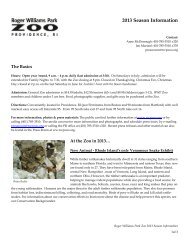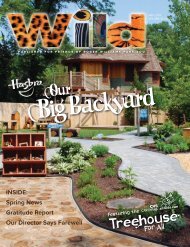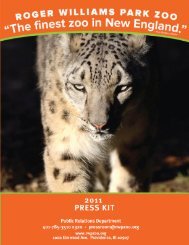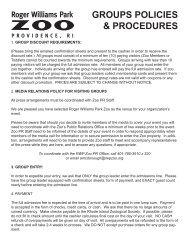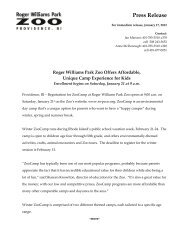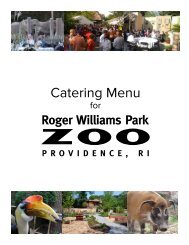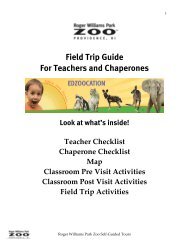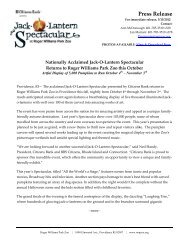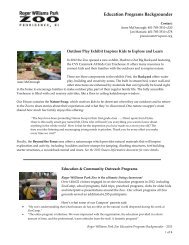View PDF - Roger Williams Park Zoo
View PDF - Roger Williams Park Zoo
View PDF - Roger Williams Park Zoo
Create successful ePaper yourself
Turn your PDF publications into a flip-book with our unique Google optimized e-Paper software.
Press Release<br />
For immediate release: January 26, 2012<br />
Contacts:<br />
RWP <strong>Zoo</strong>: Lou Perotti, 401-785-3510 x335<br />
Director, RWP<strong>Zoo</strong> Conservation Programs<br />
lperotti@rwpzoo.org<br />
RI DEM: Gail Mastrati, 401 222-4700 x2402<br />
Communications Director<br />
gail.mastrati@DEM.RI.GOV<br />
US Fish & Wildlife Service: Meagan Racey, 413-253-8558<br />
Public Affairs Specialist, Northeast Region<br />
Meagan_racey@fws.gov<br />
PHOTOS AVAILABLE: <strong>View</strong> and download now<br />
Saving the New England Cottontail Rabbit<br />
RIDEM, USFWS Wildlife Experts, and RWP <strong>Zoo</strong> Environmentalists attempting<br />
to repopulate the nearly endangered species<br />
PROVIDENCE -- The rare New England cottontail, a native rabbit once abundant throughout this region,<br />
is getting much needed help. Biologists from the Department of Environmental Management (DEM), the<br />
US Fish and Wildlife Service (USFWS), and the University of Rhode Island have teamed up with <strong>Roger</strong><br />
<strong>Williams</strong> <strong>Park</strong> <strong>Zoo</strong> and the Wildlife Management Institute to restore populations by breeding these<br />
rabbits in captivity and releasing them in natural habitat. This program has made promising progress<br />
toward boosting cottontail numbers, while additional partners continue efforts to protect and restore<br />
habitat throughout the range of this species.<br />
The collaborative project aims to help restore sustainable cottontail populations. Currently, the species is<br />
believed to be extirpated from Vermont, with sparse populations throughout the rest of New England.<br />
Recent population surveys conducted by staff wildlife biologists from DEM’s Division of Fish and<br />
Wildlife and USFWS documented only one occurrence of New England cottontail in Rhode Island.<br />
Population surveys and identification of appropriate habitat for New England cottontails in Rhode Island<br />
will continue this year by project partners with the assistance of the Conservation Genetics Laboratory<br />
located at the University of Rhode Island.<br />
-more-
Since late 2010, the partners have captured wild adult cottontails and brought them to a breeding facility<br />
housed in an off-exhibit area of the <strong>Zoo</strong>. “To try to rebuild a species, first, we have to learn if we can keep<br />
healthy individuals in captivity,” said Lou Perrotti, Director of Conservation Programs at the <strong>Zoo</strong>.<br />
“We’ve learned that we can. We’ve also learned that we can successfully breed these wild animals in<br />
captivity and raise the young from birth through weaning. Now, we are testing whether the captive born<br />
babies can be released to a wild setting and survive the winter.”<br />
On November 11, the offspring of the wild rabbits, nine bunnies aged three to four months old, were<br />
released at Ninigret National Wildlife Refuge in a one-acre habitat surrounded by predator-proof fencing.<br />
This will allow them to become acclimated to a natural environment without predation pressure. They<br />
will later be released from the pen into the wild. “So far,” says Perrotti, “they seem to be doing well.<br />
Come spring, we’ll have a better idea of whether we’ve developed husbandry protocols that can succeed<br />
on a larger scale.”<br />
This spring, DEM will oversee a pilot release of rabbits bred at the <strong>Zoo</strong>. It is planned that rabbits will be<br />
released on an island in Narragansett Bay to determine if the animals can survive and reproduce,<br />
potentially to become the source population for other restoration sites in Rhode Island.<br />
“The cottontail’s habitat needs are shared by many other species,” noted DEM Director Janet Coit, “so<br />
there are multiple benefits to this conservation initiative. We are quite enthusiastic about our ongoing<br />
efforts with the <strong>Zoo</strong> and other partners to restore sustainable populations of this native species.”<br />
“The wide-range effort to save this native animal depends on the expertise and collaboration of partners<br />
like those involved in this project,” says Anthony Tur, Endangered Species Specialist with the US Fish<br />
and Wildlife Service. “Thanks to the dedication of the zoo staff and others, we are now prepared to<br />
expand the program to achieve meaningful conservation goals for the cottontail.”<br />
-more-
RI DEM has monitored rabbits in the state for the past 60 years. Two cottontail species currently exist in<br />
Rhode Island: the native New England cottontail and another similar looking non-native rabbit, the<br />
Eastern cottontail, which was introduced during the 1930s from Missouri. While the non-native Eastern<br />
cottontail population is widespread and abundant, the native rabbit has declined perilously since that<br />
time, according to DEM biologists. The idea to use captive breeding of natives as one potential solution<br />
for saving the New England cottontail was agreed upon by DEM, RWPZ and USFWS, the three principal<br />
partners working in Rhode Island to save the rabbit. Partners from all six New England states have<br />
contributed to the development of this project, including biologists from the Connecticut Department of<br />
Environmental Protection who captured the first New England cottontails and delivered them to the<br />
<strong>Roger</strong> <strong>Williams</strong> <strong>Park</strong> <strong>Zoo</strong> to initiate the breeding phase. Genetics testing at the University of Rhode Island<br />
confirmed they were indeed New England cottontails. A Captive Breeding Working Group comprised of<br />
biologists from all six New England states and researchers from URI and the University of New<br />
Hampshire helps to inform and guide the process of transition from the breeding phase through<br />
repopulation efforts.<br />
Funding for the New England cottontail restoration project has come from a wide variety of sources<br />
including the Pittman-Robertson Federal Aid Wildlife Restoration Program, the US Fish and Wildlife<br />
Service, University of Rhode Island, and <strong>Roger</strong> <strong>Williams</strong> <strong>Park</strong> <strong>Zoo</strong>.<br />
<strong>Roger</strong> <strong>Williams</strong> <strong>Park</strong> <strong>Zoo</strong>, one of the oldest in the nation, is Rhode Island’s number one outdoor family<br />
and tourist attraction and is also a leader in conservation efforts undertaken by a zoo of its size. The <strong>Zoo</strong><br />
has received numerous awards for environmental education, and conservation work done locally and<br />
around the world, caring for species that without human intervention would face certain extinction.<br />
<strong>Roger</strong> <strong>Williams</strong> <strong>Park</strong> <strong>Zoo</strong> is supported and managed by the<br />
Rhode Island <strong>Zoo</strong>logical Society and is owned by the City of Providence.<br />
-30-



